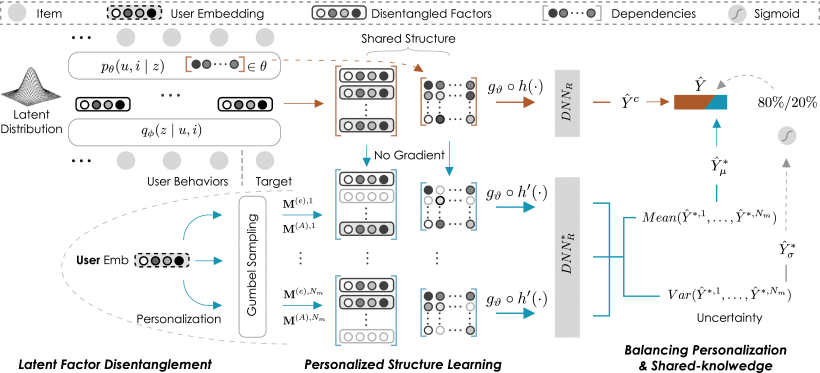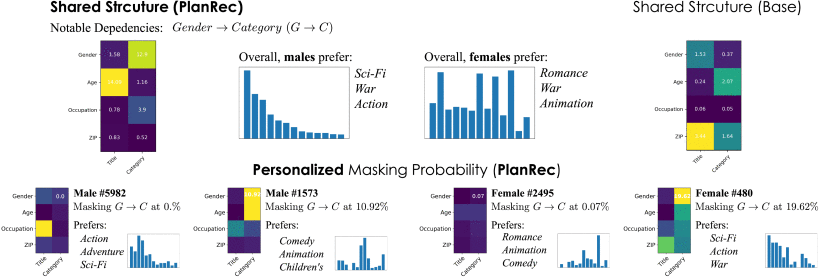In recommender systems, users’ behavior data are driven by the interactions of user-item latent factors. To improve recommendation effectiveness and robustness, recent advances focus on latent factor disentanglement via variational inference. Despite significant progress, uncovering the underlying interactions, i.e., dependencies of latent factors, remains largely neglected by the literature.

Fig. 1. An illustration of latent structure learning for recommendation, i.e., disentangling user-item latent factors and the dependencies of factors.
To bridge the gap, Professor Fei Wu, Dr Zhou Zhao, Dr Kun Kuang from Shanghai Institute for Advanced Study, Zhejiang University and collaborators investigated the joint disentanglement of user-item latent factors and the dependencies between them, namely latent structure learning. They proposed to analyze the problem from the causal perspective, where a latent structure should ideally reproduce observational interaction data, and satisfy the structure acyclicity and dependency constraints, i.e., causal prerequisites. They further identified the recommendation-specific challenges for latent structure learning, i.e., the subjective nature of users’ minds and the inaccessibility of private/sensitive user factors causing universally learned latent structure to be suboptimal for individuals.

Fig. 2. Schematic of the proposed PlanRec framework, which consists of three critical components: 1) shared structure learning that learns the shared dependencies of latent factors discovered by VAE based on three hypotheses (omitted here for simplicity); 2) personalized structure learning that probabilistically sample personalized structures conditioned on the shared structure and user embedding; 3) uncertainty estimation that measures the personalization uncertainty, and accordingly balance the predictions of personalization and shared knowledge.
To address these challenges, the authors proposed the personalized latent structure learning framework for recommendation, namely PlanRec, which incorporated 1) differentiable Reconstruction, Dependency, and Acyclicity regularizations to satisfy the causal prerequisites; 2) Personalized Structure Learning (PSL) which personalized the universally learned dependencies through probabilistic modeling; and 3) uncertainty estimation which explicitly measured the uncertainty of structure personalization, and adaptively balanced personalization and shared knowledge for different users.
They conducted extensive experiments on two public benchmark datasets from MovieLens and Amazon, and a large-scale industrial dataset from Alipay. Empirical studies validated that PlanRec discovered effective shared/personalized structures, and successfully balanced shared knowledge and personalization via rational uncertainty estimation.

Fig. 3. A visualization of the learned shared structure and the personalized masking probabilities of four sampled users. We visualize the overall item category distributions of all male/female users, and the user-specific distributions.
This work uncovered the interactions of users and items latent factors behind the decision-making patterns of all users via shared structure learning, and behind a particular user via personalized structure learning. The authors believed this new paradigm could be inspirational to the solving of some long-standing recommendation problems. The work was published in IEEE Transactions on Pattern Analysis and Machine Intelligence, and to read the full article, please visit https://ieeexplore.ieee.org/document/10053625.

